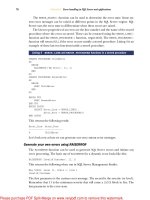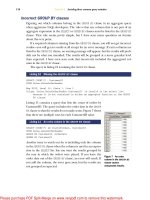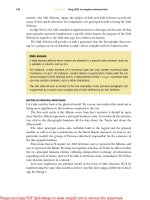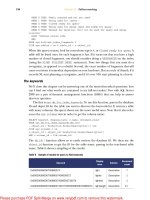PowerShell deep dives
Bạn đang xem bản rút gọn của tài liệu. Xem và tải ngay bản đầy đủ của tài liệu tại đây (15.68 MB, 464 trang )
DEEP DIVES
EDITED BY
Jeffery Hicks Richard Siddaway Oisín Grehan Aleksandar Nikolic´
●
●
●
CONTRIBUTORS
Chris Bellée Bartek Bielawski Robert C. Cain Jim Christopher Adam Driscoll Josh Gavant Jason Helmick Don Jones
Ashley McGlone Jonathan Medd Ben Miller James O’Neill Arnaud Petitjean Vadims Podans Karl Prosser Boe Prox
Matthew Reynolds Mike Robbins Donabel Santos Will Steele Trevor Sullivan Jeff Wouters
●
●
●
●
●
●
●
●
●
●
●
Author royalties go to support the Save the Children Fund
●
●
●
●
●
●
●
●
www.it-ebooks.info
MANNING
PowerShell Deep Dives
www.it-ebooks.info
www.it-ebooks.info
PowerShell
Deep Dives
Edited by Jeffery Hicks Richard Siddaway
Oisín Grehan Aleksandar Nikolic´
■
■
MANNING
SHELTER ISLAND
www.it-ebooks.info
For online information and ordering of this and other Manning books, please visit
www.manning.com. The publisher offers discounts on this book when ordered in quantity.
For more information, please contact
Special Sales Department
Manning Publications Co.
20 Baldwin Road
PO Box 261
Shelter Island, NY 11964
Email:
©2013 by Manning Publications Co. All rights reserved.
No part of this publication may be reproduced, stored in a retrieval system, or transmitted, in
any form or by means electronic, mechanical, photocopying, or otherwise, without prior written
permission of the publisher.
Many of the designations used by manufacturers and sellers to distinguish their products are
claimed as trademarks. Where those designations appear in the book, and Manning
Publications was aware of a trademark claim, the designations have been printed in initial caps
or all caps.
Recognizing the importance of preserving what has been written, it is Manning’s policy to have
the books we publish printed on acid-free paper, and we exert our best efforts to that end.
Recognizing also our responsibility to conserve the resources of our planet, Manning books
are printed on paper that is at least 15 percent recycled and processed without the use of
elemental chlorine.
Manning Publications Co.
20 Baldwin Road
PO Box 261
Shelter Island, NY 11964
Development editor: Cynthia Kane
Copyeditor: Gwen Burda, Tiffany Taylor,
and Lianna Wlasiuk
Proofreader: Melody Dolab
Typesetter: Dennis Dalinnik
Cover designer: Marija Tudor
ISBN 9781617291319
Printed in the United States of America
1 2 3 4 5 6 7 8 9 10 – MAL – 18 17 16 15 14 13
www.it-ebooks.info
To the memory and indomitable spirit of Will Steele
@pen_test
www.it-ebooks.info
authors and their chapters
Chris Bellée 28
Bartosz Bielawski 5, 13
Robert C. Cain 25
Jim Christopher 22
Adam Driscoll 14
Josh Gavant 20
Jason Helmick 27
Jeffery Hicks 17
Don Jones 1
Ashley McGlone 8
Jonathan Medd 12
Ben Miller 23
James O’Neill 9
Arnaud Petitjean 3
Vadims Podans 7
Karl Prosser 21
Boe Prox 4, 26
Matthew Reynolds 15
Mike F. Robbins 6
Donabel Santos 24
Richard Siddaway 2, 16, 19
Will Steele 11
Trevor Sullivan 18
Jeff Wouters 10
vi
www.it-ebooks.info
brief contents
PART 1
PART 2
13
15
POWERSHELL ADMINISTRATION . ........................1
1
■
Diagnosing and troubleshooting PowerShell remoting 3
2
■
CIM sessions 22
3
■
Collecting and analyzing performance counter data
4
■
TCP port communications with PowerShell 51
5
■
Managing systems through a keyhole
6
■
Using PowerShell to audit user logon events 80
7
■
Managing and administering a certification authority
database with PowerShell 93
8
■
Using PowerShell to reduce Active Directory token bloat 115
31
71
POWERSHELL SCRIPTING ...............................127
9
■
The 10 PowerShell scripting commandments 129
10
■
Avoiding the pipeline
11
■
A template for handling and reporting errors 161
12
■
Tips and tricks for creating complex or advanced
HTML reports with PowerShell 171
■
Using and “abusing” dynamic parameters 192 14
■
PowerShell type formatting
■
Scalable scripting for large data sets: pipeline
and database techniques 221
150
207
vii
www.it-ebooks.info
BRIEF CONTENTS
viii
PART 3
PART 4
16
■
Building your own WMI-based cmdlets 236
17
■
Turning command-line tools into PowerShell tools 247
POWERSHELL FOR DEVELOPERS ......................259
18
■
Using Source Control Software with PowerShell
261
19
■
Inline .NET code 270
20
■
PowerShell and XML: better together
21
■
Adding automatic remoting to advanced functions
and cmdlets 306
22
■
Taming software builds (and other complicated processes)
with psake 326
278
POWERSHELL PLATFORMS .............................341
23
■
PowerShell and the SQL Server provider 343
24
■
Creating flexible subscriptions in SSRS
25
■
Inventory database table statistics using PowerShell
and SQL Server Management Objects 368
26
■
WSUS and PowerShell 379
27
■
Provisioning IIS web servers and sites with PowerShell
28
■
Active Directory Group Management application 406
www.it-ebooks.info
354
392
contents
preface xxi
acknowledgments xxii
about this book xxiii
about Save the Children xxvi
PART 1 POWERSHELL
ADMINISTRATION .
......................... 1
EDITED BY RICHARD SIDDAWAY
1
Diagnosing and troubleshooting PowerShell remoting 3
DON JONES
Diagnostics examples 3
A perfect remoting connection 6
Connection problem: Blocked port 14
Connection problem: No permissions 16
Connection problem: Untrusted host 19
Summary 20
2
CIM sessions
22
RICHARD SIDDAWAY
WMI 22
CIM cmdlets 23
Using CIM sessions 25
CIM session options 28
Summary 30
ix
www.it-ebooks.info
CONTENTS
x
3
Collecting and analyzing performance counter data 31
ARNAUD PETITJEAN
Windows Performance Logs and Alerts
Enumerating the counter groups 32
Finding the right counters 34
Accessing the counters’ data 37
31
Controlling the sampling and the collection interval
Getting the data from remote computers 39
38
Using jobs for long-running tasks 40
Saving the performance data to a file 41
Saving the data to a binary file (BLG)
to an Excel file (CSV) 43
41
■
Saving the data
Manipulating stored performance data from a file
Summary 49
4
43
TCP port communications with PowerShell 51
BOE PROX
Testing for an open port
52
Building a more robust port checker
53
Sending and receiving data 55
Sending data
55
■
Receiving data 57
LDAP port communications 58
Testing port 389 and receiving data with portqry.exe 58
Testing port 389 and receiving data with PowerShell 58
Creating an Echo server 65
Creating a TPC port listener 65
Creating the Echo server 67
■
Handling connections and data 66
Summary 69
5
Managing systems through a keyhole 71
BARTOSZ BIELAWSKI
PowerShell remoting 71
Endpoints 72 Constrained endpoints, take one
Constrained endpoints, take two 73
■
PowerShell Web Access 76
Summary 78
www.it-ebooks.info
73
CONTENTS
6
xi
Using PowerShell to audit user logon events 80
MIKE F. ROBBINS
Event log basics 80
Querying the event logs with PowerShell 81
Auditing logon failures 83
Auditing logon type and authentication protocol 87
Auditing Active Directory user-account lockout events
Summary 92
7
90
Managing and administering a certification authority
database with PowerShell 93
VADIMS PODANS
Existing tools 93
Querying the CA database
Accessing the database 95
Querying the database 98
■
94
Getting the database schema
Advanced administration of the CA database
96
107
Required APIs 107 Certificate revocation 108 Certificate request
approval and denial 110 CA database cleanup 112
■
■
■
Summary 114
8
Using PowerShell to reduce Active Directory token bloat 115
ASHLEY MCGLONE
SIDs 101 115
Where does the SID history come from? 116
The solution 117
The script 118
Listing domain SIDs and trusts 120
The challenge 120
PowerShell options 121
Active Directory cmdlets 121
ADSI 122 .NET 123
■
WMI
■
The script solution
Summary 125
123
www.it-ebooks.info
122
■
NLTEST 122
CONTENTS
xii
PART 2 POWERSHELL
SCRIPTING .
...............................127
EDITED BY JEFFERY HICKS
9
The 10 PowerShell scripting commandments 129
JAMES O’NEILL
Constructing a sound function 129
Select your function name carefully
130
Start help early
■
130
Output 132
Keep the pipeline in mind 132 Handle and provide
a path property 133 Use Write- commands properly 133
■
■
Parameters 134
Use standard parameter names and aliases 135 Avoid restoring data:
make full use of the common parameters 135 Assign default values
(so constants can be parameters) 136 Be mindful of your users 136
Provide parameters to switch off parts of a complex function
(or script) 136 Accept input from the pipeline 137 Be flexible
about what is acceptable in parameters 138 Using parameter types
and validation properly 139
■
■
■
■
■
■
Example: finding duplicate files 142
Extra tricks for file parameters 144
Convert to paths 145 Use a path property if it exists
Pipe the same item into multiple parameters 146
■
Write code for another person to read
Summary 149
10
145
147
Avoiding the pipeline 150
JEFF WOUTERS
Requirements 150
Rules of engagement 151
Filtering objects sooner 152
Filtering by property 152 Filtering by condition
Returning only the properties that you need 154
■
153
Providers and filtering parameters 154
What’s in a name? 155
■
Where-Object isn’t bad
156
Using regular expressions 156
Using member enumeration 157
Member enumeration and properties 158 Member enumeration
and methods 158 Counting objects 158
■
■
Summary 159
www.it-ebooks.info
CONTENTS
11
xiii
A template for handling and reporting errors 161
WILL STEELE
Using preference variables: $ErrorActionPreference 162
Using structured error handling: try/catch/finally 163
Using $Error and InvocationInfo objects 164
Handling custom business-logic errors with throw and try 167
Final template 168
Summary 170
12
Tips and tricks for creating complex or advanced HTML
reports with PowerShell 171
JONATHAN MEDD
Standard ConvertTo-HTML output 171
Script parameters and help 172
ConvertTo-HTML’s –Fragment parameter 174
Using a PowerShell here-string to create
the HTML header 175
Encoding an image into the HTML report 176
Adding charts to the report 177
Preparing the data for the report 180
Differentiating report data with color 182
Final steps 182
Summary 190
13
Using and “abusing” dynamic parameters 192
BARTOSZ BIELAWSKI
Static parameters 193
Practical applications
■
Dynamic parameters
197
Using dynamic parameters 197
■
“Abusing” dynamic parameters 201
Summary 206
14
195
PowerShell type formatting 207
ADAM DRISCOLL
Creating a formatting file 209
View definitions 209
Defining table headers 210
www.it-ebooks.info
CONTENTS
xiv
Conditional row entries 212
Grouping 214
Custom controls 214
Putting it together 216
Loading formatting data 219
Summary 220
15
Scalable scripting for large data sets: pipeline
and database techniques 221
MATTHEW REYNOLDS
The stream and the water balloon 221
Streams and water balloons in PowerShell scripts
222
The problem: holding everything in memory at once 222
The solution: stream over input items instead of collecting them 224
Pipelines are not the enemy of efficiency 225
Making it real: streaming over data in complex
realistic tasks 226
If it quacks like a database … 230
Getting started 230 Getting the data to the database 232
Getting objects and insights back from the database 233
Exploring your PowerShell data outside of PowerShell 234
■
Summary 235
16
Building your own WMI-based cmdlets 236
RICHARD SIDDAWAY
Discovering WMI-based cmdlets 236
Creating a WMI-based cmdlet 238
Using a WMI-based cmdlet 239
Adding extra filter parameters 240
Creating cmdlets from WMI methods 242
Summary 246
17
Turning command-line tools into PowerShell tools 247
JEFFERY HICKS
Requirements 247
Conversion techniques 248
Looking for PowerShell data formats 248
Handling CLI errors 253
www.it-ebooks.info
■
Parsing text output 251
CONTENTS
A practical example
Summary 257
PART 3 POWERSHELL
xv
254
FOR DEVELOPERS .
..................... 259
EDITED BY OISÍN GREHAN
18
Using Source Control Software with PowerShell 261
TREVOR SULLIVAN
Requirements 261
When to use source control 262
Introduction to Mercurial 262
Command line versus GUI 263
Common source control operations 264
Initializing a repository 264 Adding files 265
Committing a new changeset 265 Removing files
■
■
Using Mercurial from PowerShell
Script to initialize a repository
267
■
Working with Mercurial in teams
Alternative Mercurial web services
266
267
Script to commit a changeset
268
269
Summary 269
19
Inline .NET code 270
RICHARD SIDDAWAY
.NET class for output
Output types 270
■
270
Creating a .NET class for output 271
.NET class with methods
Summary 276
20
274
PowerShell and XML: better together 278
JOSH GAVANT
What is XML? 279
XML in .NET and PowerShell 282
Get-Content 282
■
[xml]
283
Adapted objects and XMLNodeAdapter 284
CIM (WMI) adapted objects 285
■
www.it-ebooks.info
XML adapted objects 287
267
CONTENTS
xvi
Read and write XML documents 293
Read an XML answer file 293
■
Modify and save XML data
297
Special XML cases 299
Object serialization
299
■
Web service communication 302
Summary 304
21
Adding automatic remoting to advanced functions
and cmdlets 306
KARL PROSSER
Delivering economic value 306
An automatic remoting example 307
The pain of manual Invoke-Command 308
of increasing complexity 309
Defining the user experience
■
The pain
310
It all starts with ComputerName 310 Inspiration from Workflow 311
Is ComputerName alone sufficient? 312 Of parameters
and parameter sets 313
■
■
Implementing your solution 314
Inner and outer functions and script blocks 315 Inserting the inner
function and making it work 315 Testing your solution 317
■
■
Making it more standard
Enabling pipeline support
318
319
Dealing with the real world and gotchas
321
Accommodating PowerShell versions 321 Dealing with modules 322
Streaming binary DLLs to the target server 322 Making your cmdlets
production-ready 323 “Protecting” intellectual property
and positioning your module as a product 324
■
■
■
Summary 325
22
Taming software builds (and other complicated processes)
with psake 326
JIM CHRISTOPHER
Building software 327
Introducing psake 327
Installing psake 328
psake build scripts
■
psake commands 328
329
www.it-ebooks.info
CONTENTS
xvii
Running the build script 330
Building Visual Studio projects 331
Using PowerShell in psake tasks 333
Configuring the build with properties
Validating property values
334
336
Managing psake script growth
337
Identifying public tasks 338 Describing your tasks
Grouping tasks into files 339
■
338
Summary 340
PART 4 POWERSHELL
PLATFORMS
. ............................ 341
EDITED BY ALEKSANDAR NIKOLIC´
23
PowerShell and the SQL Server provider
343
BEN MILLER
Requirements 343
Introduction to the SQL Server provider 344
Using the SQL Server provider 345
Examples of using the SQL Server provider 346
Getting a count of databases in an instance 350
Finding a table in many databases 351
Summary 352
24
Creating flexible subscriptions in SSRS 354
DONABEL SANTOS
Understanding SSRS subscriptions 354
Environment settings 355
Requirements 356
SQL Server and PowerShell requirements
Subscription requirements 356
Subscription in action
356
358
Main script 358 Storing subscriptions 359
Retrieving subscriptions 359 Parsing parameters 361
Delivering subscriptions 363 Scheduling the script 365
Taking it further 367
■
■
■
Summary 367
www.it-ebooks.info
CONTENTS
xviii
25
Inventory database table statistics using PowerShell
and SQL Server Management Objects 368
ROBERT C. CAIN
Understanding SMO 368
Loading SMO 369
The Server object 370
Creating the inventory database using SMO 371
Creating the TableStats table using SMO 372
Resetting from previous runs 374
Gathering inventory data 374
Querying the data 375
Other ways to use the data 376
Summary 378
26
WSUS and PowerShell
379
BOE PROX
WSUS server configuration and events 379
Initial connection 379 Viewing WSUS configuration 380
Viewing the WSUS database connection 381 Viewing WSUS
event history 382
■
■
Automatic approval rules
Locating approval rules
Reporting in WSUS
383
383
■
Creating approval rules
384
386
Failed update installations
Client update status 389
386
■
Auditing approvals
387
Summary 391
27
Provisioning IIS web servers and sites with PowerShell 392
JASON HELMICK
Rapid IIS deployment 394
Transferring website files and certificates 396
Enabling remote management for IIS Manager 397
Creating a load-balanced web farm 399
Creating an SSL website 401
Automating the process 403
Summary 405
www.it-ebooks.info
CONTENTS
28
xix
Active Directory Group Management application 406
CHRIS BELLÉE
Requirements 406
User Interface development tools 407 Data storage tools
and design 407 Automation and auditing 408
Organizing the project files 409
■
■
Designing the UI 409
Rendering the UI
410
■
Adding UI event-handling logic
Handling database interactions
Executing SQL statements 417
■
412
417
Implementing UI error handling
Writing the Active Directory modification script 420
Summary 422
index
423
www.it-ebooks.info
419
www.it-ebooks.info
preface
While I was finishing another book project for Manning, a discussion developed about
a PowerShell Deep Dives book. In the past Manning published two volumes of a SQL
Server Deep Dives book written by a number of SQL Server MVPs and members of the
SQL community. The chapters were intended as in-depth content on specific aspects
of SQL Server. At the time, many of us involved in this book were also part of the
developing PowerShell Deep Dives conference.
That event brought Microsoft MVPs and community members together for a few
days of intense PowerShell togetherness. Think of it as a geeky Woodstock festival for
PowerShell. The intent was to share PowerShell experiences and ideas on specific—or
even niche—topics that would be hard to cover in a larger conference like Microsoft
TechEd. The PowerShell Deep Dives conference eventually became the PowerShell
Summit that we enjoy today.
The idea behind this book was to take that conference concept and put it into
book format. The chapters would be short explorations of specific PowerShell ideas—
things that might be presented at the PowerShell Summit. Some of the content in this
book has actually been presented at these conferences.
I was “volunteered” to serve as lead editor and began my new career as cat wrangler. A call went out and many people offered to contribute chapters to the book as well
as act as section editors. Eventually, we had a tentative table of contents and our volunteer authors started writing.
Volunteer is the key word here as nobody associated with this project is receiving any
royalties or advances. Instead, all royalties will be donated to charity, which was also a
part of the SQL Server Deep Dives project. In purchasing this book in any format, you
are supporting the outstanding work of Save the Children.
On behalf of the authors and my coeditors, we are grateful for your support and
interest in our collective work. Are you ready to dive in deeply and uncover some
PowerShell treasures?
JEFFERY HICKS
xxi
www.it-ebooks.info
acknowledgments
First, I must thank all of the contributors to this book, including their families and employers. Writing a book is a major undertaking, regardless of whether you are writing 30 chapters or one. For many of my coauthors this book is their first publication, so not only do I
want to thank them, I also want to congratulate them. This book would never have happened without the contributions of these members of the PowerShell community.
Next, I couldn’t have shepherded this book to completion without the assistance
and advice of section editors Oisín Grehan, Richard Siddaway, and Aleksandar Nikolic´.
I think the project was more involved than they anticipated and I appreciate their
willingness to stick it out with me—especially Richard who volunteered for section
editor duty in addition to contributing three chapters of his own!
All of us would like to thank the terrific people at Manning: Cynthia Kane, Michael
Stephens, Mary Piergies, Barbara Mirecki, Kevin Sullivan, Melody Dolab, Lianna
Wlasiuk, Tiffany Taylor, Gwen Burda, and Maureen Spencer. These few are just the tip
of a fantastic iceberg of enthusiastic people who kept us on track, supported this project, and, in the end, made it all possible.
Special thanks to our peer reviewers, who read the chapters during development
and provided invaluable feedback: Adam Rodgers, Allan Miller, Dave Pawson, Don
Westerfield, Douglas Duncan, James Berkenbile, Jeff Dykstra, Klaus Schulte, Mike
Shepard, Subhasis Ghosh, and Thomas Lee.
Finally, a sincere thank-you to the PowerShell community. It is no overstatement to
say that this community is extremely active, supportive, and welcoming. I’m amazed
not only at how members of the community absorb and welcome contributions like
this book, but also at how they give and share so much of what they’ve learned with
others. This is an incredible group of people. Without their interest and support, this
project would not have come to fruition. Your enthusiasm enriches us all, and especially the lives touched by Save the Children.
xxii
www.it-ebooks.info
about this book
This book is for anyone with an interest in PowerShell. Perhaps you want to learn what
you can accomplish or perhaps you’re trying to solve a problem and you see a chapter
that will help. While the majority of the chapters in the book are written for IT pros,
there is plenty of content for developers and others whose PowerShell experience may
be more peripheral.
We’re assuming you have some fundamental PowerShell knowledge. If you’re an
absolute beginner, much of the content will be lost on you. This book isn’t intended as a
tutorial for learning PowerShell, but it should teach you how to accomplish certain tasks
or take advantage of a PowerShell feature that goes beyond the core documentation.
In any event, this is PowerShell content you likely won’t find any place else, written
by PowerShell experts and MVPs.
What version of PowerShell do I need?
This book isn’t targeted at any particular version of PowerShell. There are some chapters that are PowerShell 3.0-specific and that should be evident from reading the
chapter. The safest assumption is that you’re using at least PowerShell 2.0.
Where’s coverage of Microsoft Exchange?
As we were assembling content for this book, we had to use what contributors wanted
to write about, but we also wanted to keep the book broad in scope. Yes, there are a
few chapters that are SQL Server-related, but many of the concepts and techniques
can apply to other PowerShell situations.
Frankly, products like Microsoft Exchange, which rely heavily on PowerShell,
deserve their own Deep Dives book, and we hope someone from the Exchange community will step up and lead the effort for a similar book, hopefully with some good
PowerShell content. The same is true of other Microsoft products such as SharePoint
and Active Directory.
xxiii
www.it-ebooks.info
ABOUT THIS BOOK
xxiv
How the book is organized
This book is divided into 4 parts, each centered on a PowerShell theme:
■
Part 1—PowerShell administration
■
Part 2—PowerShell scripting
■
Part 3—PowerShell for developers
■
Part 4—PowerShell platforms
This isn’t necessarily a hard and fast division. Some chapters could easily have been
assigned to multiple parts. Since the book isn’t intended as a tutorial, you can jump
from chapter to chapter as you see fit. An effort was made within each section to order
content in such a way as to facilitate learning.
Code conventions and downloads
All source code in listings or in text is in a fixed-width font like this to separate
it from ordinary text. We’ve tried to make any code that’s shown as a listing available
as a download. You should test and review all code samples in a non-production environment. None of the code listings should be considered production-ready.
Throughout the book you will see shorter code examples. Many of these are oneline expressions. Due to printing limitations we have had to take a few liberties with
how code is presented. You might see a command presented like this:
PS C:\> Get-service | where {$_.status –eq 'running'} | select
➥ status,displayname
or like this
Get-service |
where {$_.status –eq 'running'} |
select status,displayname
It is the same one-line command. We are trusting that you have enough fundamental
PowerShell knowledge to understand what a basic command looks like and how to use
it either in the shell or a script.
The source code for the examples in this book is available online from the publisher’s website at www.manning.com/PowerShellDeepDives.
Author Online
The purchase of PowerShell Deep Dives includes free access to a private web forum run by
Manning Publications, where you can make comments about the book, ask technical
questions, and receive help from the authors and from other users. To access the forum
and subscribe to it, point your web browser to www.manning.com/PowerShellDeepDives.
The Author Online forum and the archives of previous discussions will be accessible
from the publisher’s website as long as the book is in print.
www.it-ebooks.info









